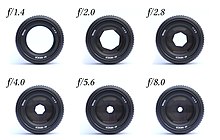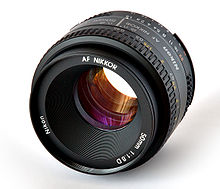Light intensity (photography)
The photographic light intensity is the maximum focal ratio of a lens . In many imaging optical devices, such as telescopes , the aperture ratio can be formed from the diameter of the entrance pupil (the aperture ) and the focal length . This ratio of two lengths is dimensionless and is often given in the form normalized to one in the numerator . Its reciprocal value is the dimensionless f-number , which is also used in photography :
With many lenses , the aperture can be varied ( fade in and out ) by means of an adjustable diaphragm or by setting the f-number :
The focal ratio is one of the fundamental properties of an optical structure and determines the illuminance in the image plane. The f-number indicates the absolute diameter of the diffraction disks in the image plane. In many optical devices, the focal length and the maximum aperture in the form are used instead of the aperture ratio
specified, for example for a lens with a focal length of 50 millimeters and a minimum adjustable f-number of 1.8:
The focal ratio of an objective whose aperture is inaccessible inside can be determined from the aperture angle on the image side . For large distances ( object distances ) the following applies:
Examples
The lens of the Hubble Space Telescope has with and a luminous intensity of .
An indication of "50 mm 1: 1.8" or "50 mm f : 1.8" on the normal lens of a full-frame camera means: focal length , light intensity 1: 1.8, minimum f-number 1.8 and consequently a maximum aperture .
Typical and maximum aperture (light intensity)
Typical amateur telescopes have an aperture ratio between and , typical camera lenses luminous intensities between and and maximum f-numbers from 16 to 64.
The smallest technically possible f-number of a corrected lens results from the Abbe sine condition of 0.5. However, due to the aperture error (or spherical aberration ) of the optical image, which cannot be completely corrected, the f-stop numbers that can actually be reasonably achieved are higher.
Normal lenses (50 mm in 35mm format ) usually move at speeds of 1: 1.2 to 1: 2.8. In some cases, however, they can also achieve light intensities up to 1: 1.0 and more. The brightest photographic lens was developed at Zeiss : With the Planar 50 mm f / 0.7 , film recordings of moving scenes could be made by candlelight, for example in the film Barry Lyndon by Stanley Kubrick . The fastest aspherical lens in the world is the Leica Noctilux-M 50 mm f / 0.95 ASPH. The aspherical lens counteracts the disadvantages of the aperture error and thus delivers significantly sharper and better image results.
Variable aperture (light intensity)
The largest focal ratio for zoom lenses can depend on the set focal length. For example, the designation 70−300 mm ƒ / 4.0−5.6 means that with the short focal length of 70 millimeters the largest aperture with the f-number 4.0 and with the long focal length of 300 millimeters the largest aperture with the f-number 5.6 lies.
Additional optical elements, such as telecompressors, can increase the light intensity of a lens while reducing the focal length. This generally leads to vignetting or a reduction in the usable image circle . Conversely, the use of teleconverters reduces the speed of lenses while increasing the focal length.
Special lenses
The technically unusable Super-Q-Gigantar ƒ / 0.33 / 40 mm was built by Zeiss in 1960 for public relations and was never used as a lens.
The Planar ƒ / 0.7 / 50 mm , also manufactured by Zeiss in 1966, is considered to be the fastest lens in the world.
Importance in photography
exposure
The illuminance of the image related to the object brightness (image brightness) increases quadratically with the aperture ratio or decreases quadratically with the f-number. For a photograph at twice the f-number, four times the exposure time is necessary to achieve the same light value. The scale values of a series of diaphragms are typically spaced apart by a factor of root 2 : 1.4 - 2.0 - 2.8 etc., so that the required exposure time per step changes by a factor of two.
Optimal aperture
Beneficial aperture
Depth of field
The choice of the f-number influences the depth of field : the larger the f-number, the smaller the blur circles due to the more pointed light cone. As a result, the depth of the area of the subject that is still in focus increases until the permissible limit value ( circle of confusion diameter , here 0.1 mm) is reached. The area of the sharp image (depth of field) increases when the aperture is closed. It follows:
- Depending larger the f-number is, the more the depth of field (for the smaller the aperture).
- The smaller the f-number, the narrower the depth of field (because the larger the aperture).
This also results in the hyperfocal distance (or hyperfocal distance). If you focus on this distance, the image becomes infinitely (acceptably) sharp. This distance therefore offers the greatest depth of field .
In the parlance of photography, the term aperture is often used as a short form for aperture , and for example, instead of large aperture, it is spoken of large aperture . This usage is common, but it can lead to misunderstandings, as a large aperture corresponds to a small f-number (and vice versa).
With some single -lens reflex cameras , the photographer can control the depth of field with the help of the preview button . The camera then activates the working aperture .
Sharpness
The resolution of an objective increases with the aperture. With the same focal length, a lens with a larger focal ratio generally produces a sharper image of a flat object. This is counteracted by the fact that the correction of aberrations of the objective does not work as well as the aperture increases. In addition, due to the more obtuse angle of the beam, it is practically more difficult to set the focal point exactly.
Film grain / pixel size
Practical advantages and disadvantages
- Manual focus: The high light intensity of SLR cameras benefits the brightness of the viewfinder image and makes focusing easier. In addition, the larger aperture is associated with a smaller depth of field , which means that the position of the plane of focus in the viewfinder can be better assessed. Setting aids for manual focusing, such as cross- sectional indicators , only work to a limited extent or not at all with low-light lenses (f / 5.6 or less). Cameras with an electronic viewfinder or live view on a screen can display an electronically brightened image which, if necessary , can even be enlarged using a software magnifying glass. In cameras that focus without the lens, this aspect is irrelevant.
- Autofocus (AF): SLR cameras sometimes have autofocus phase comparison sensors with differently sized measuring bases. In principle, the camera can focus more precisely with sensors with a larger measuring base. This requires lenses with a higher light intensity suitable for the respective sensor.
- Image design: Lenses with high light intensities expand the creative scope. For example, high-light lenses in the moderate wide-angle and telephoto range enable the subject to be cut out against a blurred foreground or background. Here, however, the following also applies: the larger the recording format , the more striking the game with sharpness and blurring (important when choosing digital cameras with their different sensor formats; in fact, however, this is not due to the size of the sensor, but to the focal length of the lens changes with the size of the sensor in order to be able to display the same image section on sensor areas of different sizes).
- A high light intensity enables shorter exposure times or the use of lower film speeds with higher resolution and finer grain , or with digital cameras, lower noise by using a lower ISO setting.
- Larger, heavier and more expensive than comparable optics with a lower light intensity.
- The low depth of field (also called DOF, English depth-of-field ) places high demands on the autofocus and slight misalignments become visible more quickly (see focusing errors ).
- An open aperture cannot be used with very bright lenses if the depth of field is too small for the desired subject with large film or image sensor formats.
History and Development
Light intensity
In general, the light intensity of lenses could be increased significantly. While the (very simple and affordable) box cameras of the 1920s and 1930s had a typical largest aperture of 1:11, more expensive medium format models from the 1950s already had 1: 4.5 or even 1: 2.8. In the 1930s, 35mm cameras had maximum apertures of 1: 3.5, especially from the 1950s onwards, openings of up to 1: 2.0 (single-lens reflex cameras from the 1960s up to 1: 1.2).
Comparatively bright lenses have been around for a long time. An example of this is the Petzval lens , which was designed jointly by Josef Maximilian Petzval and Peter Wilhelm Friedrich von Voigtländer in 1840. With an open aperture of 1: 3.6, it was 22 times faster than Daguerre's lens from 1839, which, under favorable conditions, enabled portraits with exposure times of less than a minute for the first time. The Petzval lens was produced by Voigtländer and sold worldwide with great success. By 1862 he had produced 60,000 pieces.
The lens design has a major influence on the possibility of producing lenses with a high speed. By using lens combinations of different types of glass such as crown and flint glass , CaF 2 lenses, ED glasses and the integration of aspherical lenses , aberrations could be kept small despite the large numerical aperture .
The Cooke triplet , which was developed by Harold Dennis Taylor in 1893 , represented a milestone . In the case of inexpensive lenses, it enabled a speed of up to 1: 3.6 (mid-1930s) and, after the introduction of lanthanum glass, up to 1: 2.8. It is still used today.
F-number
Up to around 1890 there were many different units of measurement for specifying the luminous intensity of a lens and the amount of light allowed through at a certain aperture, which were often determined differently from manufacturer to manufacturer. I.a. Goertz, Voigtländer, Zeiss and Dallmeyer each had their own units of measurement. The f-number common today became generally accepted in the course of the 1890s, although Kodak used the older British uniform system (US) for its lenses until the 1920s . This designated the light intensity of an f: 4 lens as “U. S. 1 "and quadrupled this value for every factor two in the f-number, so that an f: 8 lens can be classified as" U. S. 4 “was marked.
literature
- Eugene Hecht: optics. Oldenbourg, 4th edition 2005, ISBN 3-486-27359-0
Web links
- Luminous intensity unit conversion (Bionity.com)
- History of high-speed 35mm lenses
- Luminous intensity in olypedia.de
Individual evidence
- ↑ The notation " f : 1.8" Although aware of the f-number ( English f number ), provides as a fraction, however, the aperture is.
- ↑ Opening - Sinus Conditions , in Wikibook: Digital Imaging Methods , accessed on February 11, 2018
- ↑ Guinness Book of Records 1997 category The Art: Photography . Hamburg 1996.
- ↑ Carl Zeiss Super Q Gigantar 40mm f0.33: The fastest lens ever made? Retrieved August 7, 2013 from Petapixel.com
- ^ John A. Hodges: Photographic Lenses: How to Choose, and How to Use , Bradford, Percy Lund & Co., 1895
- ↑ Beginner's Troubles. In: John A. Tennant (Ed): The Photo-Miniature. Tennent & Ward, New York, 1910–1912, limited preview in Google Book search.
























